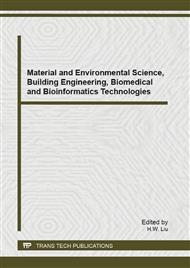[1]
S. Peeta and A. K. Ziliaskopoulos: Foundations of Dynamic Traffic Assignment: The Past, The Present and The Future, Networks and Spatial Economics Vol. 1 (2001), pp.233-265.
Google Scholar
[2]
D. Boyce, D. H. Lee and B. Ran: Analytical Models of The Dynamic Traffic Assignment Problem, Networks and Spatial Economics Vol. 1 (2001), pp.377-390.
Google Scholar
[3]
W. Y. Sezto and H. K. Lo, Dynamic traffic assignment: review and future research directions, Journal of Transportation Systems Engineering and Information Technology, Vol. 5, No. 5 (2005), pp.85-120.
Google Scholar
[4]
J. S. Mun, Traffic performance models for dynamic traffic assignment: an assessment for existing models, Transport Reviews, Vol. 27, No. 2(2007), pp.231-249.
DOI: 10.1080/01441640600979403
Google Scholar
[5]
L. Wismans, E. V. Berkum and M. Bliemer, Modelling externalities using dynamic traffic assignment models: a review, Transport Reviews, Vol. 31, No. 4(2011), pp.521-545.
DOI: 10.1080/01441647.2010.544856
Google Scholar
[6]
W. Y. Sezto and S. C. Wong, Dynamic traffic assignment: model classifications and recent advances in travel choice priinciples, Central European Journal of Engineering, Vol. 2, No. 1(2012), pp.1-18.
DOI: 10.2478/s13531-011-0057-y
Google Scholar
[7]
T. Akamastu and B. Heydecker, Detecting dynamic traffic assignment capacity paradoxes in saturated networks, Transportation Science, Vol. 37, No. 2(2003), pp.123-138.
DOI: 10.1287/trsc.37.2.123.15245
Google Scholar
[8]
D. Braess, A. Nagurney and T. Wakolbinger, On a paradox of traffic planning, Transportation Science, Vol. 39, No. 4(2005), pp.446-450.
DOI: 10.1287/trsc.1050.0127
Google Scholar
[9]
R. Arnott, A. D. Palma and R. Lindsey, Properties of dynamic traffic equilibrium involving bottlenecks, including a paradox and metering, Transportation Science, Vol. 27, No. 2(1993), pp.148-160.
DOI: 10.1287/trsc.27.2.148
Google Scholar
[10]
C. F. Daganzo, Queue spillovers in transportation networks with a route choice, Transportation Science, Vol. 32, No. 1(1998), pp.3-11.
DOI: 10.1287/trsc.32.1.3
Google Scholar
[11]
T. Akamatsu, A dynamic traffic equilibrium assignment paradox, Transportation Research, Vol. 34B, No. 6(2000), pp.515-531.
DOI: 10.1016/s0191-2615(99)00036-3
Google Scholar
[12]
X. N. Zhang, H. K. L. William and H. J. Huang, Braess's paradox in dynamic assignment with simultaneous departure time and route choice, Transpormetrica, Vol. 4, No. 3(2008), pp.209-225.
Google Scholar
[13]
W. H. Lin and H. K. Lo, Investigating braess' paradox with time-dependent queues, Transportation Science, Vol. 43, No. 1(2009), pp.117-156.
DOI: 10.1287/trsc.1090.0258
Google Scholar
[14]
X. N. Zhang and H. M. Zhang, Simultaneous departure time/route choices in queuing networks and a novel paradox, Networks and Spatial Economics, Vol. 10(2010), pp.93-112.
DOI: 10.1007/s11067-007-9026-7
Google Scholar
[15]
W. Y. Sezto, and H. K. Lo, Properties of dynamic traffic assignment with physical queues, Journal of the East Asia Society for Transportation Studies, Vol. 6(2005), pp.2108-2123.
Google Scholar


